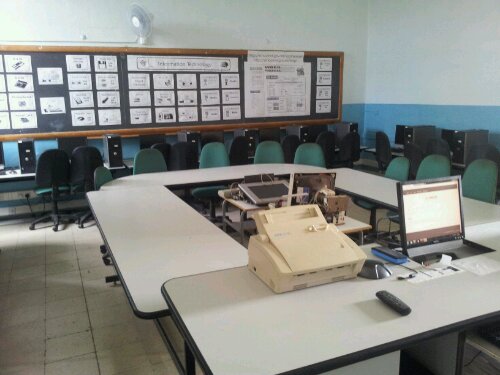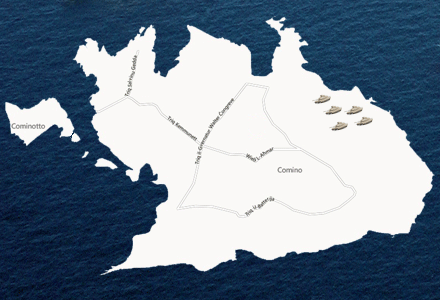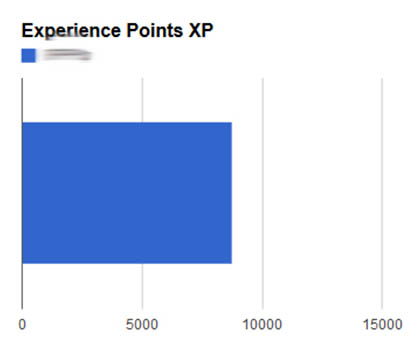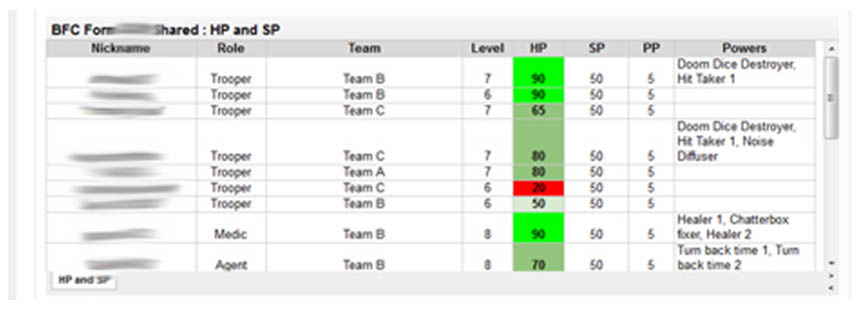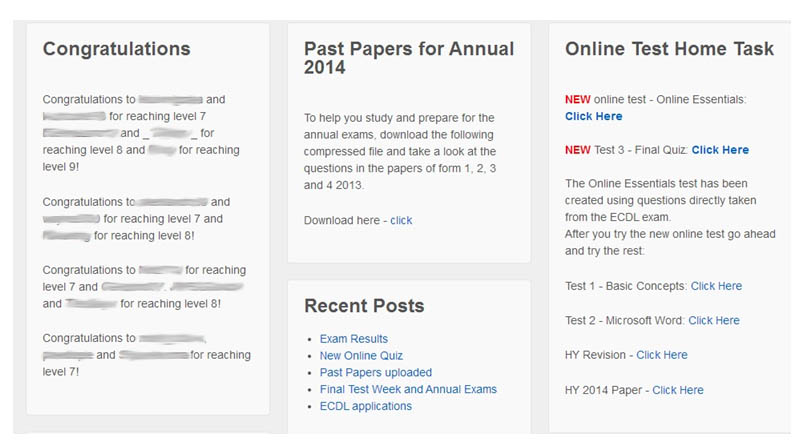5) Set-up of the multiplayer classroom
5.1 Expectations of participants in the multiplayer classroom
The usual school rules had to be observed; the differences were that participants belonged to a team, had roles with ‘special powers’ and could refer to each other by their chosen nicknames. Although they were sat in pairs as usual they could assist any team member during class activities. Classes were divided into three teams, making use of the classroom (figure 5.1) layout, with three rows of computer desks surrounding the room’s perimeter.
|
Contents 5 Set-up of the multiplayer classroom 5.1 Expectations of participants in the multiplayer classroom 5.3 Timetable 5.4 Multiplayer classroom design 5.5 Website |
Lessons commenced with a ‘random event’ and since all participants had agreed to ‘play’ they had to abide by the result of the random event, be it positive or negative. Participants had online profiles but logging on was not mandatory, nor was there any obligation to complete online tasks at home; those who did were rewarded with extra XP and special badges.
Click here to view the presentation that was presented to the students at the beginning of term.
5.2 Classwork and activities
The MG and CG were given the same classwork and activities; the only difference was that the MG were rewarded with XP (figure 5.2). The MG had a map showing them which sector they were completing and how much XP they would gain per item, as well as how many sectors remained until they had to face ‘The Boss’ (topic test).
Figure 5.2: Task for MG (Left) and CG
5.3 Timetable
| 2013 | October | Multiplayer Classroom commenced |
| November | First ‘End of Level Boss’ (test for manipulation and control groups) | |
| December | Midway Questionnaire (manipulation groups only) | |
| 2014 | January | Second ‘End of Level Boss’ (test for manipulation and control groups) |
| February | ‘End of Game Boss’ (half-yearly examinations for all students) | |
| Final Questionnaires (manipulation and control groups) | ||
| March | Semi-structured interviews (manipulation groups only) |
Table 5.1
For the duration of the study (Table 5.1), unstructured class observations of both the control and manipulation groups were recorded in an online blog [1]Access was restricted to the blog: a username and password were only given to my tutor. at http://www.automalta.com/msc immediately following each lesson. I kept an Excel spread sheet on my work PC [2]My work PC was password protected. which contained records of XP, HP and the random event. If a participant lost HP, the reason was also logged.
Questionnaires were completed online [3]Limesurvey individually but simultaneously during class-time; it was hoped that since I was there to clarify any queries, the risk of inaccurate responses would be reduced.
Eight participants took part in the two semi-structured interviews: four participants were selected at random from MG1 and MG2 and were asked if they would like to take part in an interview; students were told that there was no obligation to take part and could refuse if they wished. All agreed; they were also told that they could stop participating at any point.
5.4 Multiplayer classroom design
Whitton’s (2010) ten defining game characteristics (Competition, Challenge, Exploration, Fantasy, Goals, Interaction, Outcomes, People, Rules, Safety) were a useful starting point for my initial ideas for the multiplayer classroom design.
Rules: rules of the game were read out to the students then posted online [4]See Appendix 6.1
Rewards:
Experience Points (XP) = rewarded for positive actions
Special Powers (SP) = awarded after a certain amount of XP were gained; e.g. 200XP = 10 SP
Levelling up = once a certain number of XP were achieved, participants ‘levelled up’.
Badges = rewarded progress and effort
In addition, negative actions were reprimanded with Hit Points (HP). Students began the game with 100 HP: if this reduced to zero, students had to roll a ‘doom die’ with 6 possible outcomes, adding to the random element associated with games.
Fantasy: The narrative (The Battle for Comino) and role playing (Trooper, Medic and Agent) provided elements of fantasy. The story goes: after diamonds were found on Comino, the island was invaded by evil forces – it is up to the students to take it back. Comino is one of the smallest islands of the Maltese archipelago, with a population of four. It used to be home to a pig farm, so the idea that anyone would invade the island was humorous: the students
laughed when they saw the website’s animation with planes, tanks and warships arriving at Comino (figure 5.3).
Figure 5.3: Animated image of ‘The Battle for Comino’
Element of curiosity and chance: every lesson commenced with a spin of an online ‘fruit machine’ (figure 5.4) – ‘the random event’ – which determined bonus points, special privileges, quizzes, or possibly negative events, such as loss of HP [5]See Appendix 6.2 .
Figure 5.4: Random Event spinner
Game master: The Game master’s role (i.e. my role) was to weave the narrative, tasks and students’ roles together, and control non-player aspects of the game, e.g. keeping score, updating the website (Sheldon, 2012).
Players: Students were assigned to a team and given a role with certain ‘powers’ (linked to SP) [6]See Appendix 6.1.5 . They choose a nickname and had an online profile where achievements (XP, badges) were displayed.
Teams: Classes were divided into three teams and could choose a team name.
Challenge: Tasks were set in line with the syllabus.
Goals: Completing tasks, progressing through levels, culminating in the ‘End of Game Boss’.
Competition: A leader board and team leader board were displayed on the website
Safety: Lessons were held in a controlled environment and tasks were set within the students’ ability level.
5.5 Website
I installed WordPress as a content management system on my own site (automalta.com/private) using a free theme [7]‘Respopnsive’ by CyberChimps.com that would resize itself according to screen resolution. I also installed the WordPress application on a tablet update the site ‘on the go’. The website contained all notes, news, online tests and past papers for revision and included an area where participants could log on to their own private profiles. Profiles could be personalised, including changing the password and adding a profile image. The control group had access to another website (automalta.com/ict) which contained the same study material as the manipulation groups, but did not have private profile pages since control groups were not rewarded with XP, badges or any other features from an MMORPG.
I used Google drive and Google docs to create bar graphs which were displayed on individual profiles as a graphical representation of individual progress (figure 5.5), emulating an XP bar found in MMORPG.
Figure 5.5: Experience Points (XP) bar graph displayed on profiles
Two spread sheets per MG were created: one was only visible to individual participants and contained their XP bar; a second spread sheet was visible to all participants in that class displaying nicknames, roles, teams, levels, HP, SP, PP and Powers (figure 5.6).
Figure 5.6: Team allocation, Role, Level, HP, SP, PP and Powers acquired
HP level had a colour grade: 100 HP were displayed in dark green, gradually getting lighter as the HP decreased, and changing to red when the participant reached 20 HP, indicating a sense of imminent danger. These spread sheets were updated during or after the lesson and any badges[8]Badges were custom made using Adobe Photoshop and were designed to go hand-in-hand with the activities. acquired were also added to personal profiles.
The website also included a ‘congratulations’ area (figure 5.7) which displayed the usernames of participants who had ‘levelled up’ or attained a special achievement.
Figure 5.7: Home page
Footnotes
| ↑1 | Access was restricted to the blog: a username and password were only given to my tutor. |
|---|---|
| ↑2 | My work PC was password protected. |
| ↑3 | Limesurvey |
| ↑4 | See Appendix 6.1 |
| ↑5 | See Appendix 6.2 |
| ↑6 | See Appendix 6.1.5 |
| ↑7 | ‘Respopnsive’ by CyberChimps.com |
| ↑8 | Badges were custom made using Adobe Photoshop and were designed to go hand-in-hand with the activities. |
